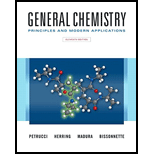
(a)
Interpretation:
Compound that is able to get oxidized easily is to be identified. Structure of the product formed in the neutralization reaction should be written.
Concept introduction:
Alcohols can be oxidized to the corresponding
(b)
Interpretation:
Compound that is able to neutralize aqueous sodium hydroxide is to be identified. Structure of the product formed in the neutralization reaction should be written.
Concept introduction:
Neutralization reaction corresponds to the combination of an acid and a base to form salt and water.
(c)
Interpretation:
Compound that is able to form ester is to be identified. Structure of the product formed in the Esterification reaction should be written.
Concept introduction:
Ester formation takes place when alcohol combines with a carboxylic acid in the presence of dilute sulphuric acid. It proceeds via the Fischer esterification mechanism.
(d)
Interpretation:
Compound that can be oxidized to a carboxylic acid is to be identified. Structure of the product formed in the oxidation reaction should be written.
Concept introduction:
Alcohols on vigorous oxidation oxidize to carboxylic acid but aldehydes are more reactive towards oxidation.
Primary alcohols upon oxidation give aldehyde and secondary alcohol give
(e)
Interpretation:
Compound that can be reduced to alcohol should be identified.
Concept introduction:
Reduction is the reaction which involves the gain of hydrogen species. Aldehydes are the class of organic compound that is capable of being reduced to an alcohol.
Alcohols can be oxidized to the corresponding acid and similarly, the carboxylic acid can be reduced to the corresponding alcohol.
Want to see the full answer?
Check out a sample textbook solution
Chapter 27 Solutions
Generl Chem Looself&mod Mst/et&stdy Crd Pkg, 11/e
- Lipoic acid is required by many microorganisms for proper growth. As a disulfide, it functions in the living system by catalyzing certain oxidation reactions and is reduced in the process. Write the structure of the reduction product.arrow_forward(a) Name each of the following compounds and its functional group. (1) CH3CH2 CH2OH (2) CH3CH2NH2 (b) Name the product from the reaction of compounds 1 and 2 above. (c) What is the name and structure of the product from the oxidation of 1 with an excess of oxidizing agent? (d) Give the name and structure of the compound that results from combining 2 and 3. (e) What is the result of adding an acid (say HCl) to compound 3?arrow_forwardCan 3-hexanol be easily made from hexanoic acid via reduction why or why not when trying to oxidize a primary alcohol to an aldehyde, why do you have to carefully choose your oxidizing agent and/or reaction conditions? Why is this not an issue in biological organism? Fully describe why amines are based in organic chemistryarrow_forward
- Using a secondary alcohol of your choice as an example: i)give the displayed formula of the product it could be oxidised to ii)state which homologous series the product belongs to iii)write a balanced chemical equation tor the reaction (the convention [O] may be used for the oxidising agent).arrow_forwardNylon can be destroyed easily by strong acids.Explain the chemical basis for the destruction.(Hint: The products are the starting materials of thepolymerization reaction.)arrow_forwardPotassium permanganate and potassium dichromate are very similar in their oxidizing abilities, however there are differences. If I want to convert 4-hexen-1-ol into 4-hexenoic acid, which would be the appropriate oxidizing agent to use? Explain your answer using equations that show the two different products that would form via the two different oxidizing agents.arrow_forward
- Morphine, procaine, and xylocaine are all solids or oily organic compounds in pure form. Why are they reacted with mineral acids such as hydrochloric acid, sulfuric acid, or phosphoric acid for injection? Why is nitric acid avoided for this process or purpose?arrow_forwardDefine Reaction of RLi and RMgX with Esters and Acid Chlorides ?arrow_forwardThe reaction of chlorobenzene with ethyl chloride in the presence of aluminum will form what product?arrow_forward
 Chemistry & Chemical ReactivityChemistryISBN:9781337399074Author:John C. Kotz, Paul M. Treichel, John Townsend, David TreichelPublisher:Cengage Learning
Chemistry & Chemical ReactivityChemistryISBN:9781337399074Author:John C. Kotz, Paul M. Treichel, John Townsend, David TreichelPublisher:Cengage Learning Macroscale and Microscale Organic ExperimentsChemistryISBN:9781305577190Author:Kenneth L. Williamson, Katherine M. MastersPublisher:Brooks Cole
Macroscale and Microscale Organic ExperimentsChemistryISBN:9781305577190Author:Kenneth L. Williamson, Katherine M. MastersPublisher:Brooks Cole Chemistry for Today: General, Organic, and Bioche...ChemistryISBN:9781305960060Author:Spencer L. Seager, Michael R. Slabaugh, Maren S. HansenPublisher:Cengage Learning
Chemistry for Today: General, Organic, and Bioche...ChemistryISBN:9781305960060Author:Spencer L. Seager, Michael R. Slabaugh, Maren S. HansenPublisher:Cengage Learning


